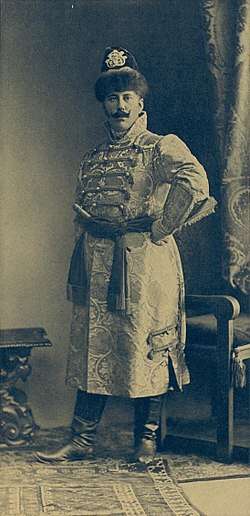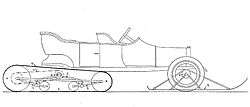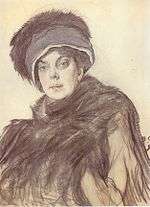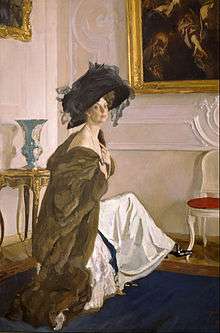Vladimir Nikolayevich Orlov
Prince Vladimir Nikolayevich Orlov (Dec. 31, 1868-Aug. 29, 1927), part of the Orlov family, was one of Tsar Nicholas II's closest advisors,[1][2][3] and between 1906 and 1915 headed the Tsar's military cabinet.[4][5]

Biography
Orlov, who bore the nickname "Fat Orlov",[6][4] may have introduced to the Tsar the motorcar in 1903,[7][8] and was married to Olga, a daughter of Prince Constantine Esperovich Beloselsky-Belozersky.[5] His son Prince Nicholas Vladimirovich Orlov (1891–1961) wed in 1917 Nadezhda Petrovna Romanov Orloff. Orlov competed in the 1900 Summer Olympics, in equestrian events.
Patron of engineers

As the head of the military cabinet, Orlov was a keen technologist interested in military applications of the motor car. He was the patron of Adolphe Kégresse, the brilliant mechanical engineer responsible for the Kégresse track. Orlov wrote in a letter to the Tsar on 15 May 1914:[9]
... I consider Kegress an irreplaceable worker and I am afraid his leaving will be a great loss for the garage. Your Highness knows, of course, how much His Majesty appreciates Kegress.
Indeed, Kégresse continued as Head of the Mechanical Department of the Russian Imperial Garage at Tsarskoye Selo until the fall of the Romanovs caused him to flee to his homeland.
Fall over Rasputin
Orlov continued his military duties until he was banished by the Tsar in 1915 to the Caucasus after losing the struggle for power to Rasputin. On August 19, 1915, after an unsuccessful attempt to discredit Rasputin and the Tsarina in a newspaper he and Vladimir Dzhunkovsky, First Deputy Interior Minister, were discharged from their posts,[10] and four days later, the Tsar took supreme command of the Russian armies fighting on the Eastern Front of the First World War.[10][11] As London Times correspondent Robert Wilton put it,[12]
The loathsome Rasputin played no small part in suggesting the Tsar’s mystical motives for taking up the High Command. Rasputin always works in the same way. He tells the Empress that he had a vision that certain things must be done, the Empress then retails this stuff to her husband and the trick is done. It reminds one of the Byzantine Court.
In exile
Orlov, exiled by events subsequent to the Russian revolution of 1917, was buried in Paris, France.[13][14]
References

- Douglas Smith: "Rasputin: Faith, Power, and the Twilight of the Romanovs" Farrar, Straus and Giroux 2016
- "The Last Diary of Tsaritsa Alexandra", Yale, 1997
- Julia P. Gelardi: "From Splendor to Revolution: The Romanov Women, 1847--1928" St. Martin's Press, 2011
- Virginia Rounding: "Alix and Nicky: The Passion of the Last Tsar and Tsarina" St. Martin's Press, 2012
- Paul Ham: "1914 The Year The World Ended", Random House, 2014
- Simon Sebag Montefiore: "The Romanovs: 1613-1918" Knopf Doubleday Publishing Group, 2016
- "WMF Report - The Imperial Garage - the Tsar and His Cars"
- Helen Nicholas: "Maelstrom", 2011
- "The Imperial Garage - the Tsar and His Cars".
- "Grigori Rasputin, the 'mad monk'"
- F. A. HOLT, ed (1925) "AN AMBASSADOR'S MEMOIRS" By Maurice Paléologue
- Vladimir Prince Orlov at Sports Reference
- findagrave.com: "Vladimir Nikolaevich Orlov"
